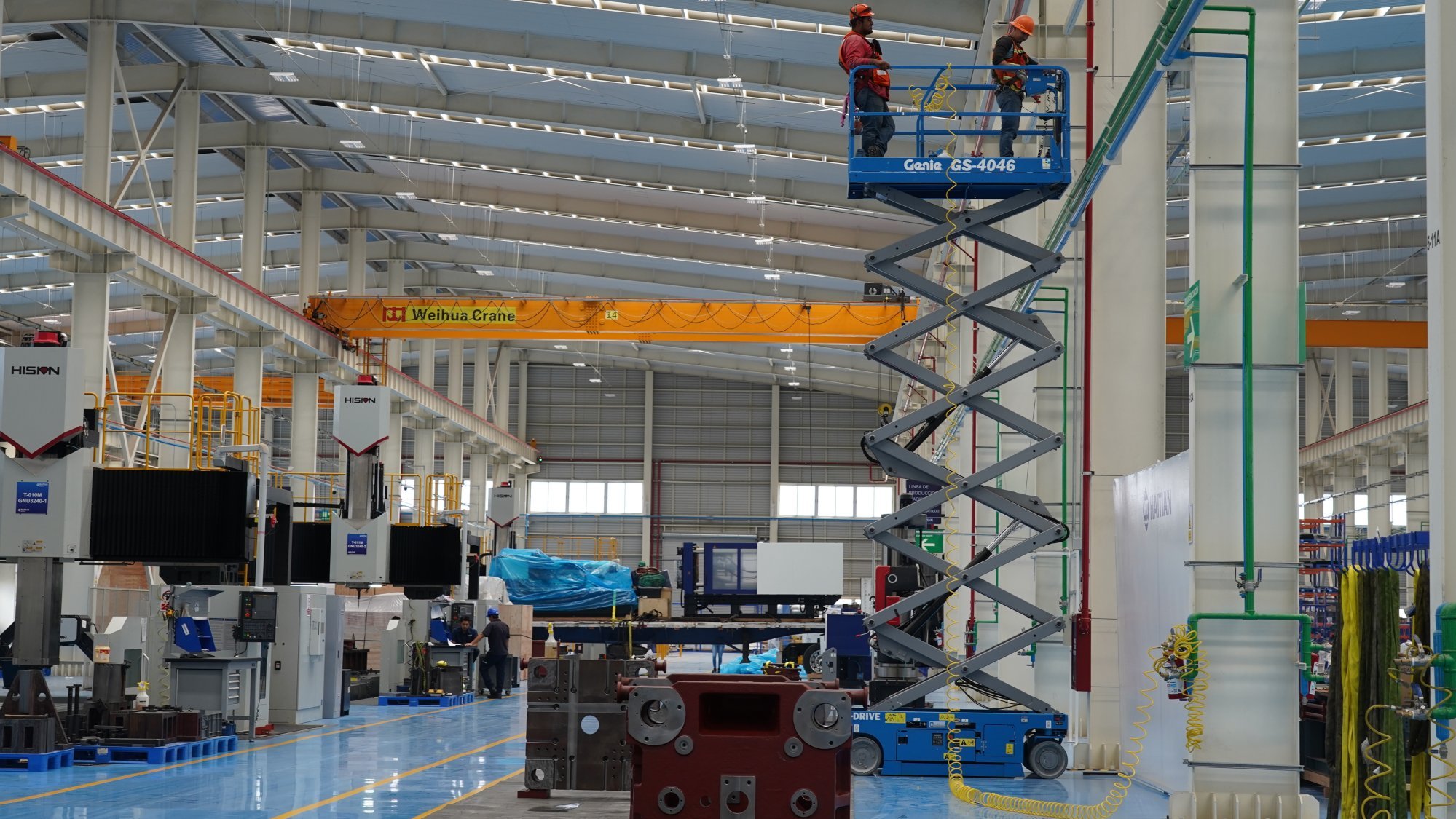
As Chinese businesses launch operations in Mexico, managers learn cross-cultural lessons
- Setting up shop in Mexico helps avoid US tariffs, but Chinese companies still must confront major concerns about labour costs, profitability and cultural differences
- The state of Jalisco awaits a decision by BYD, the global leader in EV manufacturing, whether to build a facility in the capital city of Guadalajara
In a weeds-strewn field on a 300-hectare (740-mile) undeveloped industrial land in western Mexico, tequila, local folk songs and braised pork welcomed a delegation of travellers from Shenzhen, China in February.
Dispatched by BYD, the world’s biggest electric vehicle manufacturer, the visitors were on a tour around the Latin American country looking for potential sites to build a car factory that could hire 6,000 local workers.
The land is what Centro Logistico Jalisco, the biggest industrial park in the state of Jalisco, offered BYD. And it was already equipped with a power substation, water pipes, and railway lines, all of which are essential facilities sought by industrial manufacturers.
“I think it was a nice way of imagining and dreaming about the project being on the land,” said Gabriela Martin, the park’s general manager.

For two distant countries, the attraction goes both ways. Mexico has become a hot destination for Chinese manufacturers heading overseas, and local officials in Mexico are also flocking to China, hoping to woo more investment from companies there, offering huge incentives - from tax breaks to free land.
Still, for many Chinese firms that do venture out, or wish to, concerns linger over profitability, policy uncertainties and safety – as well as vast differences in the work cultures.
“It was very tough to convince or to try to explain to Chinese companies from mainland China why they should come to Mexico and what the benefit was. But this has changed dramatically,” said Cesar Fragoso, executive vice president at the China Chamber of Commerce and Technology Mexico.
We believe that in the coming years, [Chinese investment] will increase at least tenfold
The shift came when former US president Donald Trump initiated the trade war with China in 2018. The restructuring of US-China trade has benefited Mexico, a key destination for US “nearshoring” – where products that meet certain rules of origin can enter the American market with zero tariffs.
After Covid, the trend further “exploded”, Fragoso added: “Two years ago, [Chinese investors] basically understood that the situation of trade between China and the US was not going to be better, it was only going to get worse.”
Initially, Chinese companies expanding into Mexico focused primarily on the US market, particularly those that set up plants in the northern states near the border.
With ‘made-by-China’ under US pressure, Mexico’s trade probes spark concerns
But as the industrial chain in Mexico gradually extended and local acceptance of Chinese-branded products increased, many companies began to develop their Mexican consumer markets.
The shift was especially noticeable in sectors like renewable energy and electric vehicles, which are not only seen as future economic growth engines by the Mexican government but are also dominated by Chinese companies in the global supply chain.
Investors venturing into Jalisco – whose capital Guadalajara is nearly 1,290km (800 miles) from the US border and much closer to the large container port of Manzanillo – typically don’t view the state as a “back door” to the American market, according to Roberto Arechederra, Jalisco’s secretary of economic development.
Instead, they see the state as the “front door” to Mexico and South America.
“What BYD told us is their plant would serve the local market, not export to the US,” Arechederra said.
BYD did not immediately respond to requests for comment.
Last year, investment from Chinese companies in Jalisco was still just US$17.7 million, compared with US$777.2 million from the US, which remains the state’s leading foreign investor, Arechederra said.
However, he added: “We believe that in the coming years, this figure [for Chinese investment] will increase at least tenfold.”
Recent figures show this trend. In 2023, China was not even among the top 10 investors in Mexico. But from January 1 to March 15 of this year, the country moved up to the fourth biggest source of foreign direct investment, according to data from the Mexican Federal Ministry of Economy.
Can China’s economic recovery be sustained? 4 takeaways from March’s PMI data
Despite the rising number of Chinese companies establishing plants in Mexico, the value of individual investments is still relatively low compared with those from other countries.
It remains unusual for major international brands from China to build manufacturing facilities there; existing companies are typically suppliers for other multinationals.
“For most of the multinational companies coming and making big investments in Mexico, like Tesla, BMW, you name it, they don’t come for the local market, they come for the North American market,” Fragoso noted.
“The market in Mexico is too small. If you are coming just to sell your products in the domestic market, it doesn’t make sense to have a facility in Mexico,” he added.
Still, Victor Gonzalez, a senior adviser for China-Latin America legal affairs at Beijing-based law firm PC Woo & Zhonglun Wende and Jalisco’s special adviser for China, said many Chinese companies know that even if it is just to tap the local market, it is still worth investing in Mexico.
In 2023, Chinese cars accounted for 19.5 per cent of all car sales in Mexico, compared with only 6.4 per cent in 2019, data from Mexican Association of Automobile Distributors showed. The country was also the second-largest Chinese car importer last year, after Russia.
And Mexico “would be No 1 by far, if it wasn’t for Russia because of the conflict with Ukraine”, Gonzalez said. Amid western sanctions on Moscow and an exodus of other foreign automakers, sales of Chinese cars have soared in Russia in the wake of the Ukraine war.
Chinese companies, Gonzalez said, “can tap the local market first and understand that we can be profitable locally”.
“Then they can go ahead to see if their products can reach North America through their Mexico plants, as all other foreign companies do,” he added.

Nevertheless, the biggest issue concerning all Chinese companies - whether they have invested in Mexico or are considering it - is profitability. Operating in Mexico carries considerably higher costs and business risks than in China or Southeast Asian countries, according to several factory managers.
“Mexico is a place that combines opportunities and dilemmas,” said Chen Yi, an administration director at Hengli Mexico, a branch of a hydraulic components manufacturer based in Jiangsu, China that supplies engine equipment makers such as Caterpillar.
Language barriers and cultural incompatibility are the biggest challenges, Chen said, noting that there are significant differences in the two nations’ attitudes towards work.
For instance, she added, Chinese work culture tends to emphasise efficiency, while Mexicans often strive for a more balanced integration of personal and professional life.
“If a company wants to transplant their Chinese way of management here, it would be 100 per cent irreplicable,” she said. “Many Chinese companies have learned hard lessons.”
China’s 17-year run as top source of US imports ends as Mexico rises
The main cause of the challenges is Chinese firms’ relatively recent entry into the market. Their unfamiliarity makes them more inclined to use a Chinese management team, according to industrial insiders. But now many are actively adapting and localizing.
Haitian, an injection-moulding machine maker from China’s Ningbo city, hopes to resolve the cultural differences by blending its management teams with Chinese and Mexican staff.
Since 2021, the company has operated one of its largest factories outside China in Centro Logistico Jalisco - the first Chinese-financed plant in the industrial park.
Language was the first hurdle. The Chinese managers, who did not understand Spanish, found communicating with the locals difficult. In addition, many of the company’s operational systems were written in Chinese, which hindered training of the first teams of Mexican workers.

It also became necessary to educate the managers about Mexican labour law. Hector Renova, an administrative manager at Haitian’s Mexican branch, studied the work methods and procedures at the Ningbo headquarters and realised that many of them could not be replicated in Jalisco.
Renova explained: “I know that the laws are different in China, that an employee there can be paid for the things he produces, for example. But that doesn’t exist in Mexico. Payment is based on the number of days worked – and I can’t cut anyone’s salary.”
Given the differences, Haitian decided that every Chinese manager should have a Mexican counterpart. The company also invested in fostering unity among employees of both nationalities.
Chinese employees taught the company’s Mexican cooks how to prepare dishes from various Chinese provinces. Despite the language barrier, they learned the recipes and now offer typical Chinese menus every day. A table tennis table has also been installed in the cafeteria and the staff often organise amateur championships during lunch breaks.
“The Chinese didn’t like it when the Mexicans started winning some games,” Renova joked.
Shunned by US, China investors eye Mexico to grab North American market
He also said the factory had partnered with universities in Jalisco to hire recent graduates. This lets Haitian train new employees according to its culture while fostering a closer relationship with the local academic community.
Apart from the cultural hurdles, labour costs in Mexico are double those of many Southeast Asian countries, several Chinese factory managers said.
In the fourth quarter of 2023, the average monthly income of a Vietnamese worker was around US$290, according to Vietnam’s General Statistics Office.
In January 2024, the average hourly wage in Mexico’s manufacturing sector was US$4.10 - or more than US$600 a month, data from Mexico’s National Institute of Statistics and Geography showed.
Logistical safety and efficiency are also one of the major concerns: robberies of truck drivers are rampant.
“The key is expectation management. Just don’t always compare with everything in China,” a manager of a Chinese factory which was launched last year in Monterrey, the industrial centre of northern Mexico, said on condition of anonymity.
“We will definitely lose money in the beginning. It is just about how much time you spend to improve your cost efficiency in all aspects.”

In the same way big multinationals have brought over their smaller Chinese suppliers, the Chinese companies which set foot earlier in Mexico are also bringing over their business partners from back home - including logistics firms.
“Before last year, there were maybe only four or five Chinese logistics companies with business here,” said Chen Kang, local manager at Topasia International Logistics, a Zhejiang company which expanded to Mexico in 2022. “In the past 12 months, there seemed to be about five to 10 firms coming all at once.”
Within two years, his company has helped sharply reduce the waiting time for import customs clearance at ports and subsequent transportation to Monterrey from 30 days, sometimes to as few as seven, Chen said.
“We have brought over the Chinese working mode. Some colleagues in China are on the night shift just to support us. So our clients can always find us 24 hours a day and know the location of their containers in real time,” Chen said.
China’s BYD looking for Mexico EV plant location, Americas CEO Stella Li says
Mexico’s business community is still waiting for any announcement from BYD: whether it will decide to come, and if so, which state it will choose.
The carmaker told Centro Logistico Jalisco officials it would give them an answer about whether to buy the 300-hectare site within three months. But many doubt it will make a commitment so soon, especially as the prospect of Chinese EVs entering the US market becomes a political pinata during this presidential election year.
On Wednesday, BYD Mexico’s general director Jorge Vallejo said in an interview with Mexican newspaper Excélsior that a formal announcement for the plant will be made in the coming weeks.
“What I really want,” Arechederra, the economic secretary, said “is that they come to Mexico.
“For Jalisco, it would be a great opportunity if they do – no matter in which state, because we would have an industry that can develop suppliers for them.”






